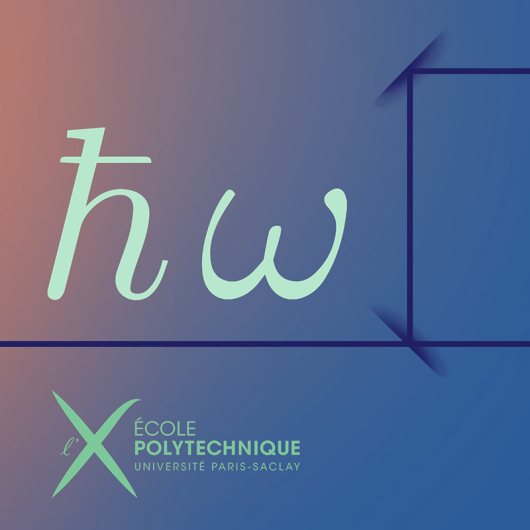- Home
- Catalog
- Online Course
- QUANTUM OPTICS: SINGLE PHOTON
QUANTUM OPTICS: SINGLE PHOTON
Start
10/28/2019
Duration
7 weeks
Rhythm
4 - 5 h/week
Prerequisites
Undergraduate knowledge of quantum mechanics and classical electromagnetism. Course on demand.
Discipline
Physics
Course language
English

PRESENTATION:
For a long time, it was thought that light could be fully described as a classical electromagnetic wave obeying Maxwell's equations. In the last decades, however, it became possible to produce new states of light with unprecedented properties, impossible to understand in the context of classical electromagnetism, and demanding the use of the quantum optics formalism. This course will introduce many basic tools of the quantum optics formalism, and use them to describe an emblematic example of fully quantum states of light: one-photon wave-packets. These tools will be also used in the follow up of this course, which will present entangled pairs of photons, squeezed states of light, interaction of quantized light with matter, and their applications to quantum technologies. Behave both as a wave and a particle, and/or how to use it in quantum technologies, embark with us!
ABOUT THE COURSE
In order to obtain the formalism of quantum optics, one must start from classical Maxwell's equations, and quantize them. One can then use the general formalism of quantum mechanics, with some adaptation. In order to benefit from the course, it is thus necessary to have some knowledge of classical electromagnetism, and of standard quantum mechanics. The course can then be considered as an advanced undergraduate course.
Quantum optics phenomena are fascinating, and the central theme of this course, wave-particle duality for a single particle (here a single photon) was declared by Richard Feynman “the great mystery” of quantum mechanics, in his famous Lectures on physics (volume III, chapter 1). The great physicist then added: ‘We cannot make the mystery go away by “explaining” how it works. We will just tell you how it works.” This is one of the goals of this MOOC, helping you to get a better understanding of quantum optics by learning how it works.
But there is another big interest in quantum optics. It turns out that quantum optics is one of the key components of the quantum technologies, which are a result of the ongoing second quantum revolution. One-photon sources play a very important role in these quantum technologies.
If you want to understand what is a photon, how it can behave both as a wave and a particle, and/or how to use it in quantum technologies, embark with us!
COURSE SYLLABUS
Week 1 : Quantization of free radiation: one mode
Canonical quantization
Material harmonic oscillator
Single mode of radiation
Canonical quantization of a single mode
Observables
Number states, photon
Vacuum fluctuations
Homework 1: quantization of a standing wave in a cavity
Week 2 : One photon in a single mode: particle-like behavior
The semi-classical model of optics
One photon in a single mode
Photo-detection signals
Single photo-detection signal for one photon
Double photo-detection signal for one photon: a fully quantum behavior
Quantum optics: a must
Homework 2: The "coherent states" of light
Week 3 : One photon interferences: Wave-particle duality
Beam-splitter in quantum optics
One photon on a beam splitter
Mach-Zehnder interferometer in classical optics
One-photon interference
Wave-particle duality: a quantum mystery; a consistent formalism
Homework 3: Field state transformation on a beamsplitter
Week 4 : Multimode quantized radiation: quantum optics in a real laboratory
Canonical quantization of multimode radiation
Eigenstates of the Hamiltonian; energy of the vacuum
Total number of photons
Linear and angular momentum of a photon
Field observables; vacuum fluctuations
Photo-detection signals
Homework 4: Multimode radiation field states: localized single photon state
Week 5 : One-photon sources in the real world
Heisenberg formalism; photo detection signals
Multimode one-photon wave packet
Spontaneous emission photon
A detour to Fourier transforms
Real one-photon sources
One-photon sources for what?
Homework 5: Generation of photon pairs by parametric down conversion
Week 6 : Wave-particle duality for a single photon in the real world
Anti-correlation on a beam splitter
Anti-correlation experiments
Supplementary photons
One-photon interference: formalism
One-photon interference: experiments
Wave-particle duality and complementarity
A fruitful mystery
Homework 6: Shot-noise limit of interferometry
Week 7 : One photon based quantum technologies
Quantum Random Number Generator (QRNG)
Weak light pulses on a beam splitter
One photon polarization as a qubit
Quantum cryptography: the BB84 scheme
The no-cloning theorem
Conclusion and outlook
SUGGESTED READINGS
The lectures are self-contained, but the learners will find useful additional information in the following book: G. Grynberg, Alain Aspect and Claude Fabre: Introduction to quantum optics, Cambridge University Press (2010).LIEN : https://www.cambridge.org/fr/academic/subjects/physics/optics-optoelect…
Teacher(s)

